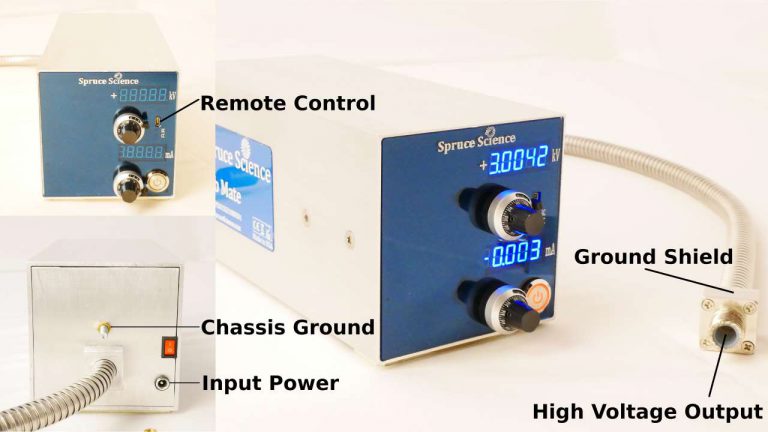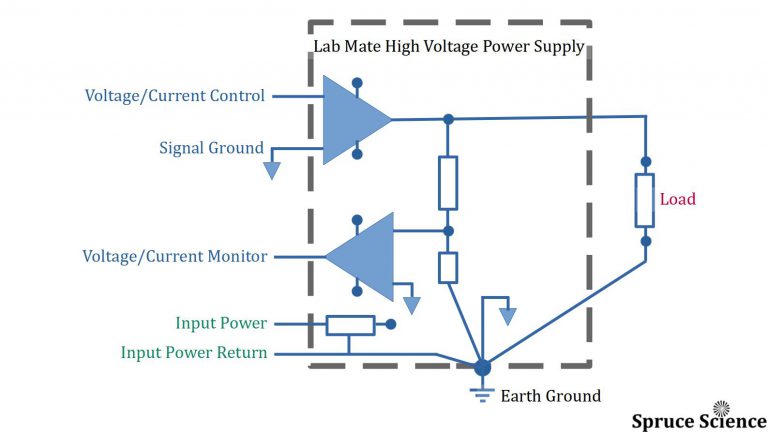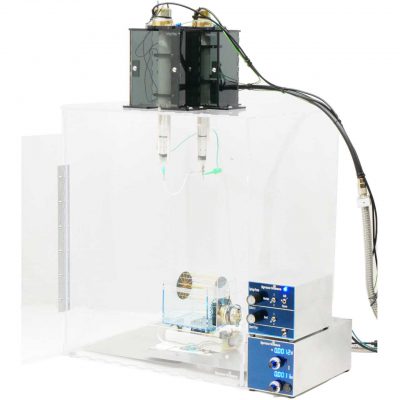High Voltage Power Supply Grounding
Table of Contents
- Introduction
- Lab Mate High Voltage Power Supply
- Input Power Return
- Input Signal Ground
- High Voltage Ground
- What is Earth Ground?
- Why can you Use Earth Ground as Ground Reference?
- Why Establish Earth Ground for High Voltage Power Supply Grounding?
- How to Add an Independent Earth Ground to a System?
- Ground Rods
Introduction to High Voltage Power Supply Grounding
High voltage power supply grounding is an important part of any high voltage applications. Proper grounding is essential for all electrical systems, devices, and equipment. It is necessary for safety purposes and helps to protect electronics and provide stability by preventing voltage fluctuations. The earth ground serves as a reference point for the voltage of the system and provides a path for electrical current to flow to the earth in the event of arcing, which is a common occurrence in high voltage applications.
Working with high voltage is unpredictable and can lead to arcing and corona discharges, which are uncontrolled events that can cause bodily harm and damage electronics. To prevent these issues, it is important to have an independent ground connection to the earth in a high voltage system. The higher the voltage, the more critical it becomes to manage the ground path and establish the proper high voltage power supply grounding technique.
When using a high voltage power supply, it is often necessary to connect it to other modules and sub-assemblies, which means managing multiple ground paths. It is important to properly manage these ground paths to ensure the high voltage output is stable and accurate. Inaccurate or unstable high voltage output can cause problems with the system and make it difficult to obtain reliable results. With the properly configured high voltage power supply grounding, you can help to ensure that the high voltage output is stable and accurate, allowing you to confidently and safely perform your experiments.

Lab Mate High Voltage Power Supply
The Lab Mate high voltage power supply is a versatile benchtop instrument that allows you to adjust the output voltage and the output current. It is a switching power supply that converts low voltage direct current (DC) into regulated high voltage DC. The power supply is equipped with a feedback loop that is fine-tuned to provide accurate, stable, and low ripple high voltage output.
You can operate the Lab Mate high voltage power supply in either constant voltage mode or constant current mode. For example, if the rated maximum voltage output is 30 kV, the output can be adjusted from 0 to 30 kV. The current output can be varied from 0 to the full rated current. The power supply is user-friendly and features an intuitive design, allowing you to easily control it from the front panel. It can also be operated remotely through the remote connector located on the front panel.
High voltage power supply grounding is an important part of equipment design and usage. This high voltage power supply has been designed with a “star” grounding technique to establish the grounding for the input power source, the programming input signals, and the high voltage return. By providing each ground with its own independent, dedicated current return path, this technique helps to ensure proper functioning and avoid issues.
Proper grounding is essential for all electrical systems, devices, and equipment. It is necessary for safety purposes and helps to protect electronics and provide stability by preventing voltage fluctuations. The earth ground serves as a reference point for the voltage of the system and provides a path for electrical current to flow to the earth in the event of arcing, which is a common occurrence in high voltage applications.
By using a star grounding technique and dedicating separate current return paths for each ground, you can help to reduce noise and interference and improve the overall performance of the system. High voltage power supply grounding is especially important and critical for ensuring stable and accurate output.

Input Power Return
An AC to DC power adapter is often used to supply a 24 V DC input to power a high voltage power supply. However, the 24 V DC power supply is a switching power supply and can contain noise. Therefore, high voltage power supply grounding is an important part of the equipment design. If the high voltage power supply is connected directly to this noisy ground, the noise and error from the AC-DC adapter can be transferred to the high voltage output, degrading system performance. Additionally, the noise can travel in both directions, so any noise from the precision high voltage power supply can also be transferred back to the 24V AC-DC adapter and cause issues with system performance.
To prevent these problems, Lab Mate high voltage power supply grounding is designed to ensure that the input supply and return do not share a path with the sensitive control circuits. This can help to isolate the noise and prevent it from affecting the performance of the system. Properly managing the grounding and separating the different parts of the system can help to ensure reliable and accurate operation of the high voltage power supply.
Input Signal Ground
In electronic devices and systems, gain and signal-to-noise ratio (SNR) are two factors that can significantly impact the performance and quality of the device. Gain refers to the extent to which a signal is amplified or increased in strength and is calculated by dividing the output signal by the input signal. For instance, a high voltage power supply that converts an input of 0 to 10 V to an output of 0 to 30000 V has a gain of 3000.
SNR, on the other hand, is a measure of the strength of a signal in relation to the level of noise or interference present in the system. Generally, higher gain and SNR values are desirable as they can improve the accuracy and reliability of a device. However, it’s also crucial to properly set the gain and SNR to prevent system overload and other issues. For instance, excessive gain can cause distortion in the output signal, while high SNR can reduce the system’s sensitivity to weak signals or small input changes.
To optimize the performance of high voltage amplifiers and other electronic equipment, it’s essential to implement proper noise-reducing design techniques and ensure proper grounding. High voltage power supply grounding that is properly implemented to handle and isolate the signal ground will help ensure reliable and accurate results.
High Voltage Ground
High voltage can be unpredictable and may result in dangerous events such as arcing and corona discharges, which can cause harm to individuals and damage electronics. It is important to take proper precautions when working with high voltage, including proper high voltage power supply grounding.
In high voltage systems, the output ground can be a source of issues. The amount of energy stored in a system is calculated by multiplying the capacitance, voltage, and the square of half of the voltage. This means that as the voltage increases, the amount of energy transferred during a high voltage discharge increases significantly. If not controlled, the peak current during an arc can reach destructive levels. The resulting high current surge can cause voltage transients on the ground path, which can damage low voltage circuits if not routed properly.
To prevent these issues, it is important to directly route the high voltage return path to the high voltage return on the power supply. Failure to use proper grounding techniques can lead to reliability problems in the field due to high voltage discharges.
What is Earth Ground?
Earth ground, also known as ground or grounding, refers to the practice of connecting an electrical system or device to the ground, typically through a conductor that is buried in the earth or otherwise connected to the earth. The purpose of grounding is to provide a low-resistance path to the earth, which can help protect people and equipment from electrical hazards, such as shocks, fires, and surges.
In electrical systems, the earth ground serves as a reference point for the voltage of the system. It provides a path for electrical current to flow to the earth in the event of a fault or other problem, which can help prevent dangerous situations, such as electrical fires or shocks. High voltage power supply grounding is an important aspect of electrical safety, as it helps to ensure that high voltage systems are properly grounded and protected. This is required by electrical codes and standards in many countries and is also a common practice in other areas, such as telecommunications and lightning protection.
Why can you Use Earth Ground as Ground Reference?
The earth can serve as a ground reference in electrical systems because it is a large conductor that is in contact with the surface of the earth. The earth’s surface is composed of a network of conductive materials, such as rock, soil, and water, that can conduct electricity.
The earth’s conductive properties allow it to dissipate electrical charges, making it a suitable reference point for electrical systems. When the high voltage power supply grounding is directly connected to the earth, a connection is established to the earth’s network of conductive materials, allowing for the flow of electrical current through a low-resistance path.
Utilizing the earth as a ground reference in high voltage power supply grounding allows for the safe dissipation of electrical charges and currents present in the system. This helps to prevent electrical hazards, such as shocks and fires, and maintains the stability of the electrical system by serving as a reference point for voltage.
The earth is used as a ground reference because it is a large conductor and it provides a low-resistance path for electrical current to flow to the earth. Adding an independent earth ground is an important part of high voltage power supply grounding. This helps to protect people, equipment and sensitive electronics from electrical hazards and maintain the stability of the high voltage power supply.
Why Establish Earth Ground for High Voltage Power Supply Grounding?
Several important reasons for establishing earth ground in high voltage power supply grounding are safety, protection, stability and compliance.
Safety is of the utmost importance when working with high voltage electrical systems. Grounding electrical systems serves as a safety measure by providing a path for electrical current to flow to the earth in the event of a fault or other issues such as arcing or corona discharges. High voltage power supply grounding will provide a layer of safety by preventing dangerous situations like electrical fires or shocks.
Proper protection is crucial for ensuring the stability of high voltage electrical systems and protecting sensitive electronic equipment. Grounding can help safeguard electrical systems and equipment from damage caused by electrical surges and other transient events, such as lightning strikes, arcing, and corona discharges. Without proper grounding, high voltage surges can potentially damage or destroy electrical equipment. So adding an independent earth ground for high voltage power supply grounding is important for proper protection.
Maintaining stability is important for precision instruments, particularly in high voltage power supplies. High voltage power supply grounding can help stabilize the electrical system by serving as a reference point for voltage, preventing voltage fluctuations that may affect sensitive electronic equipment.
One additional reason for establishing an earth ground is compliance with electrical codes and standards. Many countries require the use of grounding in electrical systems to ensure their safety and reliability.
How to Add an Independent Earth Ground to a System?
To add an independent earth ground to your high voltage system, the first step is to determine the location where the earth ground rod will be installed. This should be a location that is in contact with the earth, such as a buried rod or plate, and should be as close as possible to the electrical system or high voltage power supply that is being grounded.
The next step is to install the ground conductor, which is the conductor that will be used to connect the high voltage power supply to the earth ground. This can be a copper wire, a rod, or other type of conductor. The conductor should be buried in the ground or otherwise connected to the earth in a way that provides a low-resistance path to the earth.
Once the ground conductor is installed, it should be connected to the high voltage power supply that is being grounded. This typically involves attaching the conductor to the grounding terminal on the high voltage power supply, using a grounding clamp or other suitable connector.
After the ground conductor is connected to the high voltage power supply, it is important to test the ground connection to ensure that it is functioning properly. This can be done using a ground tester or other testing device.
It is important to follow proper safety precautions when adding an earth ground to a system. This includes wearing appropriate protective equipment and following local electrical codes and standards. If you are not familiar with electrical systems or are unsure about how to add an earth ground safely, it is recommended that you seek the assistance of a qualified electrician or other professional.
Ground Rod
A ground rod is a metal rod, typically made of copper or galvanized steel, that is used to establish an earth ground for the high voltage power supply. Ground rods are typically installed by driving them into the ground to a depth that is at least equal to the length of the rod, and ideally deeper.
The depth at which a ground rod must be inserted into the ground to establish a good ground connection can vary depending on a number of factors, including the soil type and moisture content, the size and type of the ground rod, and the local electrical codes and standards that apply.
As a general rule, ground rods should be inserted into the ground to a depth that is at least equal to the length of the rod, and ideally deeper. For example, a 8-foot ground rod should be inserted into the ground to a depth of at least 8 feet. In some cases, it may be necessary to insert the ground rod even deeper in order to achieve a good ground connection, particularly if the soil is dry or rocky.
Ground rods are an important component of electrical systems and are used to provide a low-resistance path to the earth, which can help protect people and equipment from electrical hazards, such as shocks, fires, and surges. They are also used to maintain the stability of the high voltage power supply by providing a reference point for the voltage of the system.
Ground rods are typically connected to the high voltage power supply being grounded using a grounding copper wire. The grounding conductor should be of sufficient size and be properly connected to ensure a low-resistance path to the earth.
In summary, a ground rod is a metal rod that is used to establish an earth ground for an electrical system or device. It provides a low-resistance path to the earth and helps to protect people and equipment from electrical hazards and maintain the stability of the electrical system.
Here is a useful reference on how to install ground rods:



